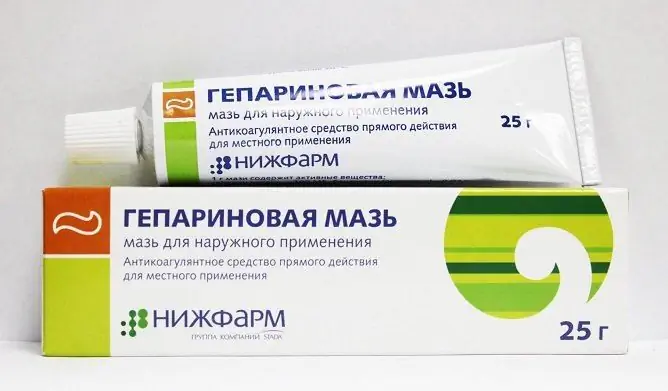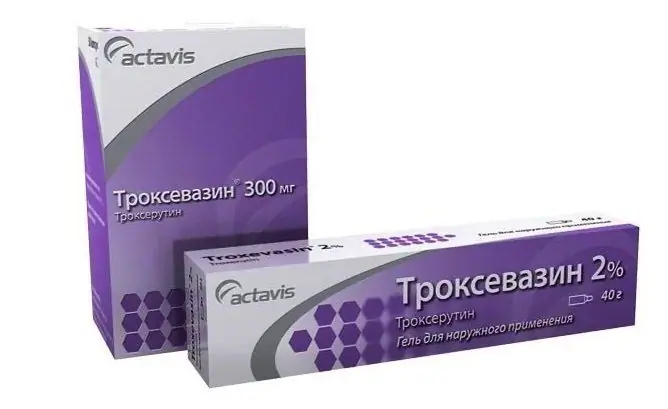- Author Rachel Wainwright [email protected].
- Public 2023-12-15 07:39.
- Last modified 2025-11-02 20:14.
Methyldopa
Methyldopa: instructions for use and reviews
- 1. Release form and composition
- 2. Pharmacological properties
- 3. Indications for use
- 4. Contraindications
- 5. Method of application and dosage
- 6. Side effects
- 7. Overdose
- 8. Special instructions
- 9. Application during pregnancy and lactation
- 10. Use in childhood
- 11. In case of impaired renal function
- 12. For violations of liver function
- 13. Use in the elderly
- 14. Drug interactions
- 15. Analogs
- 16. Terms and conditions of storage
- 17. Terms of dispensing from pharmacies
- 18. Reviews
- 19. Price in pharmacies
Latin name: Methyldopa
ATX code: C02AB01
Active ingredient: methyldopa (Methyldopa)
Manufacturer: LLC "Technology of medicines" (Russia)
Description and photo update: 2019-08-10

Methyldopa is a centrally acting antihypertensive drug.
Release form and composition
The drug is available in the form of tablets: round, biconvex, from white to grayish-white, marbling is allowed [50 pcs. in polymer (polyethylene or polypropylene) cans or bottles, in a cardboard box 1 can or bottle and instructions for use of Methyldopa].
1 tablet contains:
- active substance: methyldopa sesquihydrate - 282 mg, which is equivalent to 250 mg of methyldopa;
- auxiliary components: corn starch, povidone K, copovidone, stearic acid, magnesium stearate, colloidal silicon dioxide (Aerosil), talc.
Pharmacological properties
Pharmacodynamics
Methyldopa is a centrally acting antihypertensive agent, the therapeutic effect of which is due to the properties of alpha-methylnorepinephrine, a metabolite formed as a result of biotransformation of the active substance.
The antihypertensive effect of alpha-methylnorepinephrine is realized through the following mechanisms:
- a decrease in sympathetic tone as a result of stimulation of the central inhibitory presynaptic alpha-2 receptors;
- replacement of endogenous dopamine (as a false neurotransmitter) at dopaminergic nerve endings;
- a decrease in blood plasma renin activity, a decrease in peripheral vascular resistance, suppression of the enzyme dihydroxyphenylalanine (DOPA) decarboxylase;
- inhibition of DOPA-decarboxylase, leading to a decrease in the synthesis of dopamine, norepinephrine and serotonin, as well as the level of concentration of adrenaline and norepinephrine in tissues.
Methyldopa has no direct effect on heart function. Taking the drug does not cause reflex tachycardia, decreased cardiac output, decreased glomerular filtration rate (GFR), renal blood flow or filtration fraction. In some patients, during therapy with the drug, a decrease in heart rate (heart rate) is possible.
After taking the drug inside, blood pressure (BP) decreases in the supine and standing position, the maximum effect occurs after 4-6 hours and lasts 12-24 hours. The maximum hypotensive effect develops after regular administration of methyldopa for 2-3 days.
Orthostatic hypotension is rare.
After discontinuation of methyldopa, the blood pressure level returns to its initial value within 1-2 days.
Pharmacokinetics
When taken orally, the absorption of methyldopa is characterized by individual variability. Bioavailability averages 25%. The maximum concentration in blood plasma is reached within 2-3 hours.
Plasma protein binding is less than 20%. The substance crosses the placental barrier, enters breast milk.
Methyldopa is metabolized intensively, mainly in the liver, with the formation of an active metabolite from the central adrenergic neurons - alpha-methylnorepinephrine.
It is excreted unchanged through the kidneys about 70% of the dose taken, the rest through the intestines. The half-life (T 1/2) is 1.7 hours in patients with normal renal function, the complete elimination of methyldopa from the body occurs within 36 hours.
When carrying out hemodialysis for 6 hours, up to 60% of the absorbed dose is removed from the circulating blood, and up to 39% during peritoneal dialysis for 39 hours.
In patients with renal insufficiency, the rate of elimination of methyldopa decreases depending on the degree of renal dysfunction. In severe renal impairment, T 1/2 increases 10 times.
Indications for use
The use of Methyldopa is indicated for the treatment of arterial hypertension.
Contraindications
Absolute:
- liver disease while taking methyldopa in history;
- cirrhosis of the liver;
- acute hepatitis;
- hepatic porphyria;
- acute myocardial infarction;
- depression;
- hemolytic anemia;
- pheochromocytoma;
- concomitant therapy with MAO (monoamine oxidase) inhibitors;
- age up to three years;
- hypersensitivity to the components of the drug.
With caution, Methyldopa should be prescribed during pregnancy and lactation, in old age, in patients with hepatic porphyria in the immediate family, with renal failure, diencephalic syndrome, as well as in children over three years of age.
Methyldopa, instructions for use: method and dosage
Methyldopa tablets are taken orally before or after meals.
The doctor selects the dose individually in each case.
Recommended doses for adults:
- initial dose: during the first two days - 250 mg (1 pc.) 2-3 times a day. Then, depending on the degree of decrease in blood pressure, a gradual (with an interval of 2 days) correction of the daily dose is performed, increasing or decreasing the dose by 250 mg. To reduce the severity of the sedative effect of the drug, it is advisable to first increase the evening dose;
- maintenance daily dose: can range from 500 mg to 2000 mg, divided into 2-4 doses. In the absence of a sufficient therapeutic effect, it is recommended to prescribe a combination of methyldopa with thiazide diuretics or other antihypertensive agents;
- maximum daily dose: not more than 3000 mg.
After discontinuation of the drug, the phenomenon of rebound is not observed, after 2 days, blood pressure returns to its original values.
After 30-90 days of treatment, tolerance to methyldopa may develop; to restore effective blood pressure control, you can increase the dose or add a diuretic to the therapy regimen.
Elderly patients with methyldopa often experience fainting. In this connection, for such patients, the initial daily dose should not exceed 250 mg, which is usually divided into 2 doses. If necessary, the dose is increased at intervals of 2 days, the maximum daily dose is no more than 2000 mg.
In case of impaired renal function, correction of the dosage regimen is required, taking into account creatinine clearance (CC).
The interval between doses of the drug in patients with varying degrees of renal failure:
- light (CC 60-89 ml / min) - 8 hours;
- moderate (CC 30-59 ml / min) - 8-12 hours;
- severe (CC less than 30 ml / min) - 12-24 hours.
It is important to take into account that methyldopa is removed during hemodialysis, therefore, after each procedure, the patient should take an additional 250 mg of the drug.
Recommended dosage for children over the age of three:
- initial daily dose: determined at the rate of 10 mg per 1 kg of the child's body weight, divided into 2-4 doses. To achieve a sufficient clinical effect, the daily dose can be increased at intervals of 2 days;
- the maximum daily dose is not more than 3000 mg.
Side effects
- from the nervous system: very rarely - parkinsonism; isolated cases - headache, transient sedation, increased fatigue, general weakness, dizziness, paresthesia, Bell's palsy (peripheral paralysis of the facial nerve), involuntary choreoathetic motor activity, symptoms of cerebrovascular accident, decreased intelligence;
- invasive lesions and infections: isolated cases - inflammation of the salivary glands;
- from the immune system: isolated cases - drug fever, vasculitis, lupus syndrome;
- from the lymphatic system and blood: rarely - leukopenia, thrombocytopenia, agranulocytosis, granulocytopenia, hemolytic anemia; isolated cases - eosinophilia, bone marrow suppression;
- from the endocrine system: isolated cases - hyperprolactinemia;
- mental disorders: very rarely - nightmares, mild psychosis, depression and other mental disorders, decreased libido;
- from the side of the vessels: orthostatic hypotension, prolonged hypersensitivity of the carotid sinus;
- from the heart: very rarely - myocarditis, pericarditis, progression of angina pectoris; isolated cases - sinus bradycardia, congestive heart failure;
- from the gastrointestinal tract: very rarely - pancreatitis; isolated cases - dryness of the oral mucosa, pain of the tongue, staining of the tongue in a dark color, nausea, vomiting, constipation, diarrhea, flatulence, bloating, colitis;
- from the hepatobiliary system: isolated cases - cholestasis, jaundice, hepatitis, necrotizing hepatitis;
- from the respiratory system: isolated cases - nasal congestion;
- on the part of the skin and subcutaneous tissues: isolated cases - skin rash (similar to lichen), eczema, toxic epidermal necrolysis;
- on the part of the genitals and mammary gland: individual cases - violation of ejaculation, impotence, amenorrhea, gynecomastia, galactorrhea;
- from the musculoskeletal system: isolated cases - mild joint pain (including swelling), myalgia;
- laboratory parameters: very rarely - positive Coombs' test; isolated cases - an increase in the activity of hepatic transaminases, the level of urea concentration in the blood, positive results of tests for rheumatoid factor, antinuclear antibodies, LE cells;
- general disorders: isolated cases - peripheral edema, weight gain.
Overdose
Symptoms: dizziness, marked decrease in blood pressure, weakness, drowsiness, severe bradycardia, lethargy, tremors, nausea, vomiting, diarrhea, intestinal atony, constipation, flatulence.
Treatment: in case of an overdose, immediate gastric lavage, stimulation of vomiting, the appointment of symptomatic therapy and measures to support the vital functions of the body are required. To accelerate renal excretion, infusion therapy is prescribed. The patient is provided with control over the volume of circulating blood and electrolyte balance, heart rate, cardiac output, bowel, kidney, and brain function. If necessary, administration of adrenaline or other sympathomimetic is indicated. In order to remove methyldopa, hemodialysis is effective.
special instructions
Treatment with the drug should be accompanied by regular monitoring of the peripheral blood picture and the state of liver function due to an increased risk of hemolytic anemia, severe liver damage and positive Coombs test results while taking methyldopa.
The presence or appearance of positive responses during the Coombs' test is not a contraindication to taking methyldopa, but there is a need to establish the degree of its clinical significance and to check the patient for hemolytic anemia. A positive indirect Coombs' test can affect blood cross-compatibility, therefore, when planning a blood transfusion during therapy with methyldopa, direct and indirect Coombs tests should be performed.
When prescribing the drug, it is necessary to conduct a series of laboratory tests to determine the number of blood corpuscles, hemoglobin, hematocrit and continue monitoring them during therapy.
Transient increased fatigue, general weakness, sedation or headache may occur at the beginning of therapy and with an increase in the dose of the drug.
The occurrence of unexplained fever is the basis for a study to determine the activity of hepatic transaminases and leukocyte counts. If the activity of hepatic transaminases changes or symptoms of hepatic failure occur, Methyldopa should be stopped immediately. In addition, fever may be due to a hypersensitivity reaction requiring discontinuation of the drug. Such patients should not be further prescribed methyldopa.
If peripheral edema or weight gain occurs, diuretics are prescribed. If edema worsens, signs of heart failure appear, or hemolytic anemia is detected, methyldopa should be discontinued.
It is important to take into account that during dialysis methyldopa is excreted, therefore, an increase in blood pressure is possible after the end of the procedure.
For the relief of arterial hypotension, which has arisen against the background of general anesthesia, the introduction of vasoconstrictor agents can be used. When taking methyldopa, the sensitivity of adrenergic receptors remains.
If patients with cerebral atherosclerosis develop involuntary choreoathetoid movements, the drug should be discontinued.
Darkening (discoloration) of urine during treatment with methyldopa has no clinical significance.
The simultaneous use of alcoholic beverages is contraindicated.
Influence on the ability to drive vehicles and complex mechanisms
When prescribing the drug, the doctor must warn the patient that at the beginning of the course it is necessary to refuse to perform any potentially hazardous activities, including driving and working with complex mechanisms. After determining the maintenance dose, these limits are set for each patient individually.
Application during pregnancy and lactation
Women who receive Methyldopa during pregnancy for the treatment of hypertension require in-depth medical supervision.
The results of clinical studies indicate the absence of a damaging effect of the active substance on the fetus or newborn while using the drug in the II - III trimester of pregnancy.
During the examination of children who were born by mothers who continued to take methyldopa after the 26th week of pregnancy, no undesirable effects of the antihypertensive drug were found. It was found that in pregnant women with arterial hypertension who did not take methyldopa in the third trimester, the fetal condition was worse than in women taking the drug.
The doctor makes the decision to prescribe the drug during lactation after careful consideration and comparison of all the risks and benefits of therapy.
Pediatric use
The appointment of Methyldopa for children under the age of three is contraindicated.
The drug is used with caution in pediatric patients over the age of three years.
With impaired renal function
Care should be taken when treating patients with renal impairment.
Correction of the methyldopa dosage regimen is required in accordance with the patient's QC.
For violations of liver function
It is contraindicated to prescribe methyldopa to patients with liver diseases while taking methyldopa in history, liver cirrhosis, acute hepatitis, hepatic porphyria.
With extreme caution, the drug should be used by those patients, in whose history there is an indication of the presence of hepatic porphyria in the next of kin.
Use in the elderly
With caution, Methyldopa should be used to treat elderly patients due to the frequent occurrence of fainting. In order to prevent syncope, it is necessary to strictly adhere to the dosage regimen recommended for this category of patients.
Drug interactions
The simultaneous use of methyldopa with MAO inhibitors is prohibited.
The simultaneous use of Methyldopa with the following substances / preparations requires special care:
- sympathomimetics, phenothiazine derivatives, tricyclic antidepressants, non-steroidal anti-inflammatory drugs, estrogen drugs, as well as oral iron preparations and multivitamin complexes / dietary supplements containing iron: concomitant therapy with one of these drugs may cause a decrease in the hypotensive effect of methyldopa due to a decrease in the bioavailability of the drug;
- beta-blockers, diuretics, calcium channel blockers, other antihypertensive drugs, drugs for general anesthesia, muscle relaxants (tizanidine, baclofen), levodopa + carbidopa, tranquilizers (anxiolytics), barbiturates, alprostadil, linezolid, ethanol: enhances the therapeutic effect methyldopa; levodopa + carbidopa contribute to the development of orthostatic hypotension; during surgical interventions, patients taking methyldopa require a reduction in the dose of general anesthetics;
- bromocriptine: a change in the pharmacological effect of bromocriptine may disrupt prolactin concentration;
- lithium preparations: the risk of increased toxicity of lithium increases;
- levodopa: levodopa preparations reduce the antiparkinsonian effect, their undesirable effect on the central nervous system (CNS) is enhanced;
- verapamil: as a result of interaction with verapamil, bradycardia increases;
- beta2-adrenomimetics: severe arterial hypotension develops against the background of salbutamol infusion;
- drugs that depress the central nervous system: contribute to increased depression;
- anticoagulants: the effect of anticoagulants increases, the risk of bleeding increases;
- haloperidol: promotes impairment of cognitive functions, accompanied by disorientation, confusion;
- tolcapone, entacapone: when combined with the indicated inhibitors of catechol-O-methyltransferase, a significant change in blood pressure, an increase in heart rate, a violation of the heart rhythm is possible, therefore, careful monitoring of the patient's condition is required.
During the period of using Methyldopa, the doctor should take into account that it distorts the results of laboratory tests in the diagnosis of pheochromocytoma, determination of the concentration of uric acid in the blood and urine by the phosphotungstic method, creatinine in the blood serum by the Popper method, the level of ACT (aspartate aminotransferase) in the blood serum by the colorimetric method.
The drug does not affect the indicator of the level of concentration of vanilyl mandelic acid in urine.
Analogs
The analogues of Methyldopa are Dopegit, Aldomet, Aldomin, Dopanol, Alfadopa, Dopamet, Modepres, Medomet, etc.
Terms and conditions of storage
Keep out of the reach of children.
Store at temperatures up to 25 ° C in a dark place.
Shelf life is 2 years.
Terms of dispensing from pharmacies
Dispensed by prescription.
Reviews about Methyldop
Reviews about Methyldopa are extremely rare, but they are all positive. Patients note the mild antihypertensive effect of the drug and minor side effects, most often manifested in the form of slight dizziness, which quickly passes on its own.
Price for Methyldopa in pharmacies
Price for Methyldopa tablets 250 mg, 50 pcs. in a bottle, 1 bottle in a cardboard box, on average can be 136 rubles.

Anna Kozlova Medical journalist About the author
Education: Rostov State Medical University, specialty "General Medicine".
Information about the drug is generalized, provided for informational purposes only and does not replace the official instructions. Self-medication is hazardous to health!






